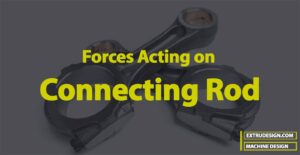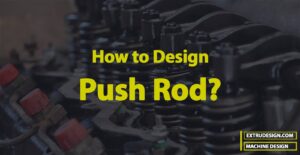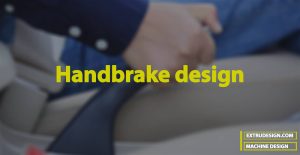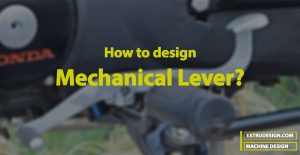The power screws (also known as translation screws) are used to convert rotary motion into translatory motion. For example, in the case of the lead screw of lathe, the rotary motion is available but the tool has to be advanced in the direction of the cut against the cutting resistance of the material. Let us discuss the […]

In Mechanical Engineering, Machine Design is subjected to creating new or Advanced machines. This involves improving the existing machines to better machines.
The design process is a time-consuming process which includes implementing an Idea and considering the commercial and economic aspects, Making the idea into a shape in the form of drawings by keeping the available resources in mind to make the actual Idea into a life.
What are the Forces Acting on a Connecting Rod?
Among the basic components of an Internal Combustion engine, the Connecting Rod for IC Engine is the most critical. The connecting rod is subjected to alternating direct compressive and tensile forces. Since the compressive forces are much higher than the tensile forces, therefore the cross-section of the connecting rod is designed as a strut and Rankine’s formula is used. […]
Design of Connecting Rod for IC Engine
Among the basic components of an Internal Combustion engine, the Connecting Rod for IC Engine is the most important and critical. The connecting rod is subjected to alternating direct compressive and tensile forces. Since the compressive forces are much higher than the tensile forces, therefore the cross-section of the connecting rod is designed as a strut and […]
How to Design Push Rods for IC Engine?
Among the basic components of an Internal Combustion engine, the Push rod is one of the critical components. The push rods are used in overhead valve and side valve engines. Since these are designed as long columns, therefore Euler’s formula should be used. The push rods may be treated as pin-end columns because they use spherical […]
How to Design a Piston Rod?
Among the basic components of an Internal Combustion engine, the Piston rod is one of the most critical components. Since this Piston rod moves forward and backward in the engine cylinder, it is subjected to alternate tensile and compressive forces. It is usually made of mild steel. One end of the piston rod is secured […]
Long Columns Subjected to Eccentric Loading
A machine part subjected to an axial compressive force is called a strut. A strut may be horizontal, inclined, or even vertical. But a vertical strut is a column, pillar, or stanchion. The machine members that must be investigated for column action are piston rods, valve push rods, connecting rods, screw jack, side links of toggle jack, etc. We discussed Euler’s […]
What is Johnson’s Formulae for Columns?
A machine part subjected to an axial compressive force is called a strut. A strut may be horizontal, inclined, or even vertical. But a vertical strut is known as a column, pillar, or stanchion. The machine members that must be investigated for column action are piston rods, valve push rods, connecting rods, screw jack, side links of toggle jack, etc. In […]
What is Rankine’s Formula for Columns?
Usually, it is a common phenomenon observed in long columns failure due to buckling load and the short columns usually fail due to crushing load. The Rankine-Gordon formula assumes a combined failure mode which is combined buckling and crushing loads in columns. This common mode is known as the Rankine formula for columns. Hence, we […]
What is Euler’s Column Theory?
A machine part subjected to a vertical axial compressive force is called a column. it is also known as a pillar or stanchion. We see this vertical axial compressive force such as piston rods, valve push rods, connecting rods, screw jack, side links of toggle jack, etc. The first rational attempt, to study the stability of long columns, […]
What is Column? | Failure of a Column
A machine part subjected to an axial compressive force is called a strut. A strut may be horizontal, inclined, or even vertical. But a vertical strut is known as a column, pillar, or stanchion. The machine members that must be investigated for column action are piston rods, valve push rods, connecting rods, screw jack, side links of toggle jack, etc. Let […]
Procedure for Designing Rocker’s Arm for Exhaust Valve
A rocker’s arm is a valvetrain component that typically transfers the motion of a push rod to the corresponding intake/exhaust valve. The rocker’s arm is used to actuate the inlet and exhaust valve motion as directed by the cam and follower. Let us see if we can design Rocker’s Arm for Exhaust Valve for a petrol […]
Find stiffness of the spring in Hartnell Governor
Hartnell Governor is basically a Centrifugal governor with a spring-loaded weight instead of dead weight on the sleeve to increase the speed of the balls required to lift the sleeve on the spindle. The Bell crank Lever holds two dead-weight balls for a Hartnell governor in order to regulate the fuel flow for the engines […]
How to Design a Bell Crank Lever?
The Bell crank lever consists of two arms at right angles. Such types of levers are used in railway signaling, governors of Hartnell type, the drive for the air pump of condensers, etc. Let us design a simple Bell Crank Lever for one of these applications. In the previous articles, we have discussed different Mechanical […]
How to Design a Lever Safety Valve?
A Mechanical Lever is a rigid rod or bar capable of turning about a fixed point called a fulcrum. It is used as a machine to lift a load by the application of a small effort. Lever Safety Valve is used to maintain a constant safe pressure inside the boiler. When the pressure inside the boiler increases the […]
How to design Foot Lever? | Foot Pump Lever
Have you ever used the foot pump for your car to inflate the tyre? Yes right there you can see the Foot Pump lever that you press with your foot to inflate your tire. That Foot Lever is nothing but a Mechanical Lever. A Mechanical Lever is a rigid rod or bar capable of turning […]
How to design Hand Lever? | Handbrake
A Mechanical Lever is a rigid rod or bar capable of turning about a fixed point called a fulcrum. It is used as a machine to lift a load by the application of a small effort. Let us discuss more on how we can design a Hand Lever for any application with the same mechanical lever […]
How to design a lever for any application?
A Mechanical Lever is a rigid rod or bar capable of turning about a fixed point called a fulcrum. It is used as a machine to lift a load by the application of a small effort. Let us discuss more on how we can design a Lever for any application you have. History of Lever […]
What is Forging? | Classification of Forging
Forging is a process of deforming the metals and alloys into desired and specific shapes by the application of repeated blows from a hammer. Forging can be done either while the metal or the alloy is hot condition or sometimes forging can be done when the metals are in cold condition. Let us discuss more […]
Why Hollow Shaft is better than a Solid shaft?
Have you ever wondered why most of the time you have seen many applications involve hollow shafts instead of solid ones? How the Hollow Shaft is better than a Solid shaft? Let us see how the hollow shafts are better than the solid ones. Differentiating the Hollow shaft and solid shaft can be done with […]
How to Calculate Shaft Diameter under Axial Load?
In the previous article, We have discussed how to calculate the shaft diameter under twisting and bending moment with the fluctuating load. In some cases such as propeller shafts of ships, there will be an additional axial load that will act on the shaft in addition to the Torsion and bending loads. Now let us […]
- « Previous Page
- 1
- 2
- 3
- 4
- 5
- 6
- …
- 11
- Next Page »




















